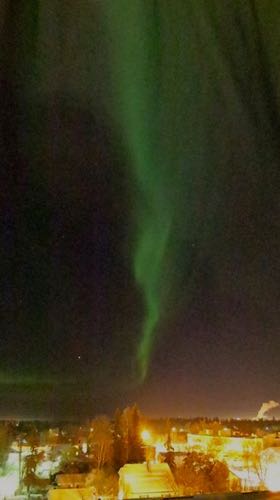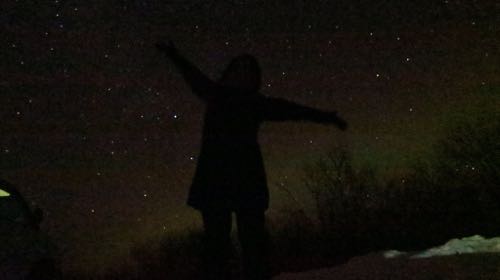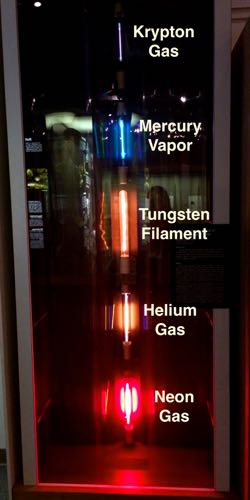It's 4:30am and I wake up to a phone call. "The Northern Lights are out! Come quick!" I throw on a sweatshirt and sprint to a friend's room on the north side of the hotel.
Wow. This was my first true sighting and The Lights did not disappoint.
A band of a greenish glow arched across the sky ending in a curtain rippling back and forth.
 It proved quite difficult to photograph the lights with my measly iPhone, so here's a look at The Lights a few days earlier taken with a high exposure camera, courtesy DJ Kast.
It proved quite difficult to photograph the lights with my measly iPhone, so here's a look at The Lights a few days earlier taken with a high exposure camera, courtesy DJ Kast.
People describe the lights as dancing and it's quite true – they're very dynamic, changing brightness and shape every few seconds.
Ten minutes later, just like that, they were gone.
 A few days earlier we took a nighttime field trip out of town to try and see The Lights. Although they weren't as visible to the naked eye, they sure made for a great picture, courtesy DJ Kast
A few days earlier we took a nighttime field trip out of town to try and see The Lights. Although they weren't as visible to the naked eye, they sure made for a great picture, courtesy DJ Kast
I'm obsessed to say the least.
Why do we see the Northern Lights?
As you my know, the sun is hot. Like really hot. Like ~10,000F at the surface and ~27,000F at the center hot. In fact, the sun is so hot that its atmosphere is boiling off as electrically charged particles, protons which are positively charged and electrons which are negatively charged. These particles are blown through space following the sun's magnetic field. We call the combination of particles and magnetic field the solar wind.
This solar wind can be more or less intense depending on solar activity. Storms on the surface of the sun, or sunspots, often come with large explosions of gas called solar flares. A solar flare can reach tens-of-thousands of miles into space and generally increase the intensity of charged particles in the solar wind.
What happens to those charged particles after they travel the 93 million from the sun to the earth? They interact with Earth's magnetic field and atmosphere!
When charged particles from the sun strike atoms in Earth's atmosphere, they excite those atoms. This means that electrons move to a higher-energy state. When the electron moves back to a lower-energy state, it releases a light particle called a photon. And voila – lights!
This is actually the same principle used to create those neon "OPEN" sign you see outside of businesses. When plugged in, electricity is used to excite the atoms of neon gas inside the glass tubes of sign. When the electrons return to a lower-energy state, you get that blinding glow we all know and love.
What colors are the Lights?
Well it depends. Just like Neon Signs can light up in different colors, the Northern lights can be different colors. It all depends on what gas the charged particle is coming in contact with.
Each gas will emit a specific wavelength of light when excited – this wavelength corresponds to the color we see. Take a look at the gases and their colors below:
 Tubes of various gases and vapors lighting up in a variety of wavelength (colors) when the electrons are excited by electricity.
Tubes of various gases and vapors lighting up in a variety of wavelength (colors) when the electrons are excited by electricity.
Common gases in our atmosphere include:
- Oxygen – glows green
- Nitrogen – glows red
- Hydrogen & Helium – glows blue & purple
So that means if our atmosphere were Neon instead of Oxygen & Nitrogen, we'd see orange Northern Lights!
Where can you see the Lights?
Around the North Pole and around the South Pole. In the north, the lights are known as Aurora Borealis and in the south they're known as Aurora Australis.
When the charged particles come in contact with earth's magnetic field, the field directs the particles towards the north and south magnetic poles. Here, the magnetic field is at such an angle that the charged particles then enter the atmosphere, colliding with gas molecules and creating the Aurora.
Alaska and northwestern parts of Canada typically have a great display of Northern Lights. Greenland and Iceland as well as Norway and waters just north of Siberia also get incredible displays. But sometimes the Northern Lights do creep down a south, sometimes as far as New Orleans, so keep an eye out! The Southern Lights on the other hand are mostly concentrated in a ring around Antarctica and in the Indian Ocean, so they're rarely observed.
How did they get their name?
Mr. Galileo Galilei (yep, that guy who was persecuted by the Catholic Church for believing in a geocentric model... oh and he discovered four of Jupiter's largest moons only using a basic telescope. Cool guy. Look him up.) originally coined the term Aurora Borealis to describe the Northern Lights. Aurora, was the name of the Roman goddess of the dawn, and Boreas was the Greek god of the north wind. Quite literally, Aurora Borealis means "dawn of the north." Conversely, Aurora Australis comes from the Latin word for "of the south," or auster, translating to "dawn of the south."

